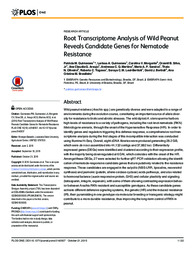Root transcriptome analysis of wild peanut reveals candidate genes for nematode resistance.
Root transcriptome analysis of wild peanut reveals candidate genes for nematode resistance.
Autoria: GUIMARAES, P. M.; GUIMARAES, L. A.; MORGANTE, C. V.; SILVA JUNIOR, O. B.; ARAUJO, A. C. G.; MARTINS, A. C. Q.; SARAIVA, M. A. P.; OLIVEIRA, T. N.; TOGAWA, R. C.; LEAL-BERTIOLI, S. C. M.; BERTIOLI, D. J.; BRASILEIRO, A. C. M.
Resumo: Wild peanut relatives (Arachis spp.) are genetically diverse and were adapted to a range of environments during the evolution course, constituting an important source of allele diver-sity for resistance to biotic and abiotic stresses. The wild diploid A.stenosperma harbors high levels of resistance to a variety of pathogens, including the root-knot nematode (RKN)Meloidogyne arenaria through the onset of the Hypersensitive Response (HR). In order to identify genes and regulators triggering this defense response, a comprehensive root tran-scriptome analysis during the first stages of this incompatible interaction was conducted using Illumina Hi-Seq. Overall, eight cDNA libraries were produced generating 28.2 GB, which were de novo assembled into 44,132 contigs and 37,882 loci. Differentially expressed genes (DEGs) were identified and clustered according to their expression profile, with the majority being downregulated at 6 DAI, which coincides with the onset of the HR. Amongst these DEGs, 27 were selected for further qRT-PCR validation allowing the identifi- cation of nematode-responsive candidate genes that are putatively related to the resistance response. Those candidates are engaged in the salycilic (NBS-LRR, lipocalins, resveratrol synthase) and jasmonic (patatin, allene oxidase cyclase) acids pathways, and also related to hormonal balance (auxin responsive protein, GH3) and cellular plasticity and signaling (tetraspanin, integrin, expansin), with some of them showing contrasting expression behav-ior between Arachis RKN-resistant and susceptible genotypes. As these candidate genes activate different defensive signaling systems, the genetic (HR) and the induced resistance(IR), their pyramidding in one genotype via molecular breeding or transgenic strategy might contribute to a more durable resistance, thus improving the long-term control of RKN in peanut.
Ano de publicação: 2015
Tipo de publicação: Artigo de periódico
Observações
1 - Por padrão são exibidas publicações dos últimos 20 anos. Para encontrar publicações mais antigas, configure o filtro ano de publicação, colocando o ano a partir do qual você deseja encontrar publicações. O filtro está na coluna da esquerda na busca acima.
2 - Para ler algumas publicações da Embrapa (apenas as que estão em formato ePub), é necessário ter, no celular ou computador, um desses softwares gratuitos. Sistemas Android: Google Play Livros; IOS: iBooks; Windows e Linux: software Calibre.
Acesse outras publicações
Acesse a Base de Dados da Pesquisa Agropecuária (BDPA) para consultar o acervo completo das bibliotecas da Embrapa.

